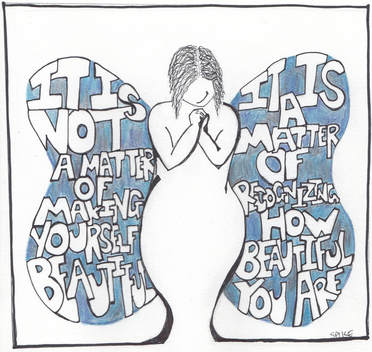 This week I am taking off my mask. My skin is molding and the stench stings my eyes. I cannot breathe, and the mask rests on the same spots on my head and nose and they are becoming irritated from wear. In Japan masks are made from cypress wood by artists who have studied the craft for years. They are made for a certain type of theatre in Japan, but the only character who wears them is the central or main character. All the supporting actors do not wear masks at all. As is the case with all Japanese art, these masks are the products of patience, a high level of skill, and a complete and utter respect for the tradition of the craft. When I am in my mask out in the world I take for granted that my supporting players are unmasked, when, chances are, they are doing the very same thing that I am doing. My mask directs my focus as to how I am seen, and how I can manuever to be seen in a certain light. I watch my responses and try to create situations in which I can feel comfortable, safe, and stable. War veterans attempt to handle their PTSD by making masks which can express their pain and anguish to the people with whom they interact. PTSD is an emotional and mental injury; one that is hidden from the world unless the person with PTSD is triggered, and even then, it is difficult to know what it is like when you are not aware of its existence. The common sentiment among the soldiers with PTSD is that they wished it were more visible to people, that if they had lost a limb or had been badly scarred, at least people would have a visual clue as to what they went through, and are still going through, but because the injury, the PTSD, is internal, there is no way for them to understand or know what is going on. The masks they create are a way for them to express this outwardly. So,who are masks for? My initial reaction is that they are for the wearer, they protect her from judgment, from the unknown. But masks also serve the people around the wearer, in that they elicit a response. The masks the soldiers with PTSD create express their turmoil because it is not socially acceptable for them to behave as if anything bothers them. It is not okay for them, or for anyone to show this type of emotion or pain because our culture and society does not allow it. Our society treats this type of human expression as weakness. We are expected to live in a cage of conformity and behave as if that is not brutality. We are expected to endure the extreme violence and aggression of this world and behave as if it is acceptable. We get up every morning, put on the masks we must use to get through the day, and wonder why we feel so empty. We behave in an acceptable manner so that the people around us can feel at ease, and inside we are empty, or worse, we are full of the rage and pain that comes from ignoring ourselves, and every time we start to feel even a little of it, we stuff it down with whatever substance or distraction we can get our hands on. We allow the violence and aggression. We condone the brutality and oppression. Then, when the abused, damaged and otherwise broken ask for help or show signs of abuse, we treat them as if they have done something wrong, as if they are weak, as if they are garbage. Maybe I will keep my mask on, for now. It really doesn't smell that bad. FB Like, Twitter, copy and paste, even sending the link to a loved one in need could help people.
|
A Love Rebellion.
Be a part of A Love Rebellion. Spread love, hope and compassion.

Artist WebsiteOnly the highlights from my creative life. Just click on the image.
Most Popular
My work is supported by my readers. If you feel like you get something out of this every week, and you feel you are able, a $3 to $15 monthly subscription will help me bring you all the ass-kicking content possible. Thanks so much for your support.
Archives
June 2019
|


 RSS Feed
RSS Feed
